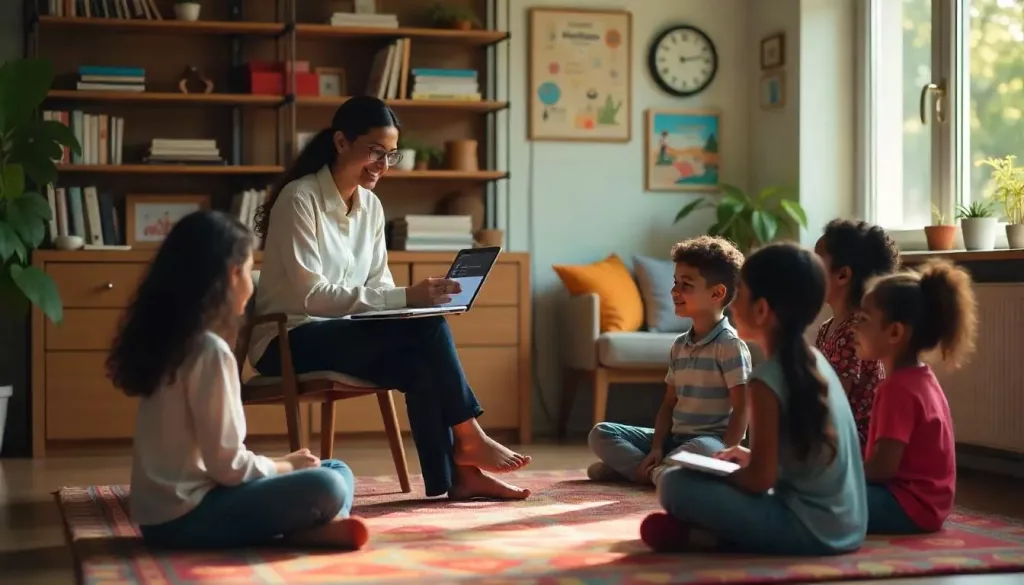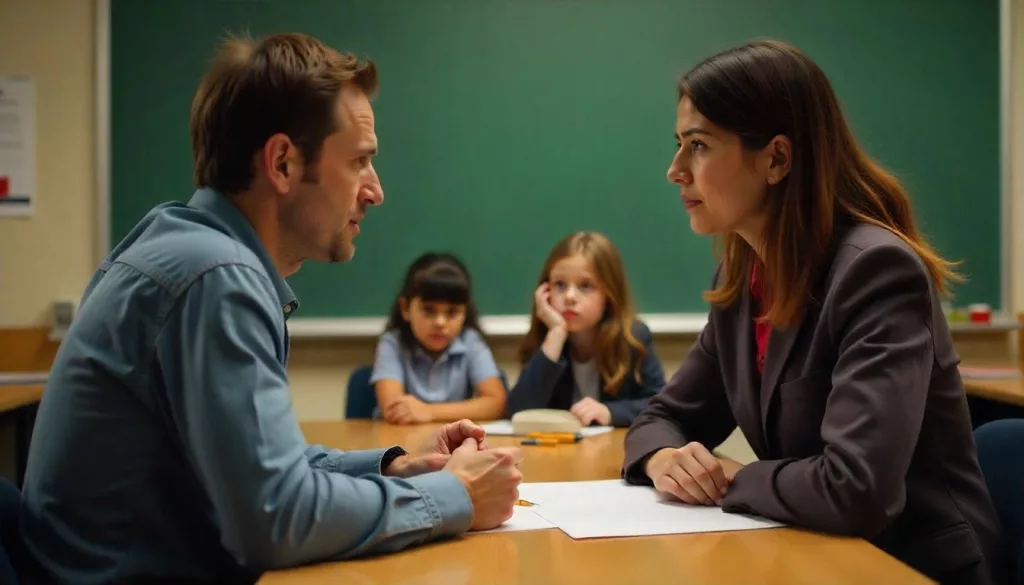
Landing your dream teaching position in 2025 requires thorough preparation for increasingly sophisticated interview processes. Modern teacher interview questions and answers 2025 reflect the evolving educational landscape, where schools seek educators who can blend traditional pedagogy with innovative approaches, technology integration, and inclusive practices.
This comprehensive guide covers the most common teacher interview questions that candidates face, providing detailed analysis of why each question is asked, strategic tips for crafting compelling responses, and sample answers to help you prepare effectively. Whether you’re facing new teacher interview questions 2025 or seeking advancement opportunities, this guide will enhance your teacher interview preparation.
Understanding Modern Teacher Interviews in 2025
Today’s teaching strategies for interviews must demonstrate your ability to handle diverse learning environments, implement social-emotional learning, and adapt to hybrid educational models. Schools are looking for educators who can support student wellbeing, manage uncertainty, and maintain high academic standards while fostering inclusive classrooms1.
Q.1: “Tell me about yourself.”
Why This Question Is Asked
This classic opener allows interviewers to assess your communication skills, professional journey, and ability to present yourself confidently. It’s particularly important for tell me about yourself teacher interview scenarios as it sets the tone for the entire conversation and helps interviewers understand what makes you unique as an educator.
Tips for Answering
- Structure your response around your professional background, key achievements, and teaching philosophy
- Keep it concise (2-3 minutes maximum)
- Focus on experiences relevant to the teaching position
- End with why you’re interested in this specific role
Sample Answer
“I’m a passionate educator with seven years of experience teaching middle school science. My journey began when I discovered my ability to make complex scientific concepts accessible to students who previously struggled with STEM subjects. In my current role, I’ve implemented inquiry-based learning strategies that increased student engagement by 40% and improved standardized test scores by 25%. I’m particularly proud of developing a peer mentoring program that paired struggling students with high achievers, resulting in improved outcomes for both groups. I’m excited about this opportunity because your school’s commitment to innovative STEAM education aligns perfectly with my teaching philosophy and experience in project-based learning.”
Q.2: “Why do you want to teach?”
Why This Question Is Asked
Interviewers want to understand your intrinsic motivation and ensure you’re passionate about education rather than viewing teaching as a fallback career. Your answer reveals your commitment level and potential longevity in the profession.
Tips for Answering
- Share a specific story or experience that inspired your teaching career
- Emphasize your desire to make a positive impact on students’ lives
- Avoid mentioning external factors like job security or schedules
- Connect your motivation to student outcomes and growth
Sample Answer
“Teaching chose me during my college years when I volunteered as a literacy tutor in an underserved community. I worked with Maria, a third grader who had been labelled as ‘behind’ in reading. Through patient, differentiated instruction and building her confidence, she not only caught up to grade level but developed a genuine love for books. Watching her transformation from frustrated to flourishing showed me the profound impact educators can have. I teach because every child deserves an advocate who believes in their potential and helps them discover their strengths. Education isn’t just about academic content, it’s about empowering students to become confident, critical thinkers who can contribute positively to society.”
Elevate Your Teaching Career with Global Teachers Olympiad
Speaking of demonstrating teaching excellence, the Global Teachers Olympiad offers educators a unique opportunity to showcase their skills internationally while gaining recognition and substantial rewards. Perfect for teachers seeking career advancement, this competition covers modern pedagogical skills like differentiated instruction, technology integration, and assessment strategies.
Why Participate & What You’ll Win:
- Global Recognition + ₹1L+ Cash Prizes for outstanding performance
- Professional Development + ₹10L+ Scholarships for further education
- Free Advanced Performance Report (Worth ₹1000) for all participants
- International Networking with innovative educators worldwide
Join thousands of educators who have enhanced their careers through global recognition and professional growth opportunities.
Register for Global Teachers Olympiad Today – GTO 2025
Q.3: “What is your teaching philosophy?”
Why This Question Is Asked
Your teaching philosophy reveals your core beliefs about education, learning, and student development. It helps interviewers understand how you approach instruction and whether your values align with the school’s mission.
Tips for Answering
- Articulate a clear, concise philosophy statement
- Connect your philosophy to specific teaching practices
- Mention current educational approaches like student-centered learning
- Provide examples of how your philosophy influences your classroom decisions
Sample Answer
“My teaching philosophy is grounded in the belief that all students can achieve excellence when provided with supportive, differentiated instruction that honours their individual learning styles and cultural backgrounds. I practice culturally responsive pedagogy, where I incorporate students lived experiences into the curriculum to make learning relevant and meaningful. For example, when teaching fractions, I might use recipes from students’ cultural backgrounds to demonstrate mathematical concepts. I view myself as a facilitator of learning rather than just a content deliverer, creating environments where students feel safe to take risks, ask questions, and learn from mistakes. My classroom operates on the principles of mutual respect, collaborative learning, and growth mindset, where effort and improvement are celebrated alongside achievement.”
Q.4: “How do you handle classroom management?”
Why This Question Is Asked
Effective classroom management is fundamental to creating productive learning environments. Interviewers want to ensure you can maintain order while fostering positive relationships and student engagement.
Tips for Answering
- Emphasize preventive strategies over punitive measures
- Discuss building relationships and setting clear expectations
- Mention specific techniques you use
- Show understanding of restorative practices
Sample Answer
“My classroom management approach is proactive, and relationship based. I begin each year by co-creating classroom norms with my students, which gives them ownership in our learning community. I establish clear, consistent routines and expectations while building authentic relationships through morning check-ins and interest surveys. When behavioural issues arise, I use the ‘least intrusive intervention’ approach—starting with proximity and non-verbal cues before escalating. I implement restorative practices when conflicts occur, focusing on understanding the impact of actions and collaborative problem-solving. For example, if a student disrupts group work, we might have a private conversation about what they need to be successful, then develop strategies together. This approach has reduced office referrals by 70% in my current classroom while maintaining high academic engagement.”
Q.5: “How do you differentiate instruction?”
Why This Question Is Asked
Modern classrooms serve students with diverse learning needs, abilities, and backgrounds. Interviewers want to ensure you can adapt your teaching to meet all students where they are academically.
Tips for Answering
- Provide specific differentiation strategies you use
- Mention how you assess student needs
- Give concrete examples from your experience
- Show understanding of various learning differences
Sample Answer
“Differentiation is essential for ensuring all students can access and engage with the curriculum. I use multiple strategies including flexible grouping, tiered assignments, and choice boards. At the beginning of each unit, I conduct pre-assessments to understand students’ background knowledge and learning preferences. For instance, when teaching a novel study, advanced readers might analyse complex literary devices while developing readers focus on character development, but all students participate in collaborative discussions about themes. I also differentiate by learning modality—providing visual graphic organizers, audio recordings, and hands-on activities within each lesson. For students with IEPs or 504 plans, I work closely with special education teachers to implement specific accommodations. My goal is ensuring every student is appropriately challenged while feeling supported in their learning journey.”

Q.6: “How do you incorporate technology in your teaching?”
Why This Question Is Asked
Technology integration is crucial in 2025 education. Schools want teachers who can effectively use digital tools to enhance learning while preparing students for a technology-driven future.
Tips for Answering
- Emphasize purposeful technology use over trendy tools
- Mention specific educational technologies you’ve used
- Discuss how technology improves student outcomes
- Address digital citizenship and equity concerns
Sample Answer
“I integrate technology purposefully to enhance learning experiences and develop students’ digital literacy skills. I use platforms like Google Classroom for assignment distribution and feedback, which allows for real-time collaboration and revision. In science classes, I incorporate virtual labs and simulations that let students explore concepts safely like using PhET simulations for physics concepts that would be impossible to demonstrate physically. I also use formative assessment tools like Padlet for exit tickets and Flipgrid for video discussions, which give voice to students who might not speak up in traditional settings. Importantly, I address the digital divide by providing alternative offline activities and ensuring all students develop critical evaluation skills for online sources. I teach digital citizenship alongside technology use, helping students understand responsible online behaviour and their digital footprint.”
Q.7: “How do you assess student learning?”
Why This Question Is Asked
Assessment drives instruction and demonstrates student growth. Interviewers want to understand your approach to measuring learning and using data to improve student outcomes.
Tips for Answering
- Discuss both formative and summative assessments
- Explain how you use assessment data
- Mention alternative assessment methods
- Address feedback and student involvement in assessment
Sample Answer
“I use a balanced assessment approach that includes both formative and summative measures to capture the full picture of student learning. Daily, I use formative assessments like exit tickets, think-pair-share activities, and quick checks to gauge understanding and adjust instruction immediately. For summative assessment, I go beyond traditional tests to include performance tasks, portfolios, and student-led conferences where learners reflect on their growth. I’m particularly proud of implementing ‘assessment as learning’ through peer feedback sessions and self-assessment rubrics, which develop students’ metacognitive skills. I analyse assessment data weekly to identify learning gaps and provide targeted interventions. For example, if several students struggle with a specific math concept, I’ll reteach using different strategies or provide additional practice materials. My assessment philosophy focuses on growth over grades, and I provide specific, actionable feedback that helps students understand their progress and next steps.”
Q.8: “How do you communicate with parents?”
Why This Question Is Asked
Parent partnerships are essential for student success. Schools want teachers who can build positive relationships with families and maintain open communication channels.
Tips for Answering
- Emphasize positive, proactive communication
- Mention multiple communication methods
- Discuss cultural sensitivity
- Show understanding of family dynamics
Sample Answer
“I believe parents are partners in their child’s education, so I prioritize positive, proactive communication. I contact families within the first week of school to introduce myself and share my classroom expectations. Throughout the year, I send weekly newsletters highlighting classroom activities and upcoming events. I make it a point to share positive news regularly—not just when there are concerns. When issues arise, I contact parents promptly and come prepared with specific examples and collaborative solutions. I’m sensitive to different family structures and communication preferences, offering multiple ways to connect including email, phone calls, text messages through school apps, and in-person meetings. I also ensure translation services are available for non-English speaking families. During parent conferences, I share student work portfolios and data showing growth over time, making the conversation student-centred and forward-looking rather than just focusing on grades.”
Q.9: “How do you support struggling students?”
Why This Question Is Asked
Every classroom has students who need additional support. Interviewers want to ensure you can identify struggling learners and implement effective intervention strategies.
Tips for Answering
- Discuss early identification strategies
- Mention collaboration with support staff
- Provide specific intervention techniques
- Show understanding of various causes of academic struggles
Sample Answer
“Supporting struggling students begins with building relationships to understand the root causes of their challenges. I use multiple data points – academic assessments, behavioural observations, and conversations with students to identify needs early. I collaborate closely with special education teachers, counsellors, and families to develop comprehensive support plans. My interventions include breaking complex tasks into smaller steps, providing additional processing time, using multi-sensory teaching methods, and offering alternative ways to demonstrate learning. For example, I had a student who struggled with traditional written assessments but excelled when allowed to present information orally. I also implement peer tutoring systems and flexible grouping to provide additional practice opportunities. Most importantly, I maintain high expectations while providing appropriate scaffolding, celebrating small victories to build confidence and motivation.”
Q.10: “Describe a challenging situation you faced and how you handled it.”
Why This Question Is Asked
This behavioural question reveals your problem-solving skills, resilience, and ability to handle difficult situations professionally while maintaining student welfare as the priority.
Tips for Answering
- Use the STAR method (Situation, Task, Action, Result)
- Choose a situation that demonstrates growth
- Show reflection and learning from the experience
- Emphasize positive outcomes for students
Sample Answer
“Last year, I had a student who was frequently disruptive, causing other students to lose focus during lessons. Initially, I tried traditional consequences, but the behaviour continued. I realized I needed to understand the underlying causes rather than just address symptoms. I met privately with the student and discovered they were struggling academically and acting out to avoid embarrassment. I collaborated with the school counsellor and implemented a plan that included academic supports, frequent check-ins, and opportunities for the student to demonstrate leadership. I also modified my instruction to include more movement and hands-on activities that better matched this student’s learning style. Within a month, the disruptive behaviours decreased significantly, and the student became one of my most engaged learners. This experience taught me the importance of looking beyond surface behaviours to understand student needs and reinforced my belief in restorative rather than punitive approaches.”

Q.11: “How do you stay current with educational trends and research?”
Why This Question Is Asked
Education constantly evolves, and schools need teachers committed to continuous learning and professional growth to stay effective in their practice.
Tips for Answering
- Mention specific professional development activities
- Discuss educational publications or resources you follow
- Show how you apply new learning to your practice
- Demonstrate ongoing commitment to growth
Sample Answer
“I’m committed to lifelong learning and staying current with educational research and best practices. I’m an active member of the National Education Association and my subject-area professional organization, which provides access to current research and networking opportunities. I regularly read educational journals like Educational Leadership and attend webinars through organizations like ASCD. I also participate in Twitter chats with educators worldwide, which exposes me to diverse perspectives and innovative practices. Last summer, I completed a course on culturally responsive teaching that significantly impacted my curriculum design. I apply new learning immediately in my classroom and share effective strategies with colleagues during our professional learning community meetings. I believe that to prepare students for their future, I must continuously update my knowledge and skills to meet their evolving needs.”
Q.12: “How do you handle stress and maintain work-life balance?”
Why This Question Is Asked
Teaching can be demanding, and schools want educators who can maintain their well-being while providing consistent, high-quality instruction to students.
Tips for Answering
- Show self-awareness about stress management
- Mention specific strategies you use
- Emphasize how balance helps you be a better teacher
- Avoid suggesting teaching is easy or stress-free
Sample Answer
“I recognize that teaching is demanding, so I’ve developed strategies to manage stress effectively while maintaining my passion for education. I prioritize time management by planning lessons in advance and using collaborative resources when appropriate, which prevents last-minute stress. I set boundaries by designating specific hours for schoolwork and protecting time for personal activities that recharge me, like hiking and reading. I practice mindfulness techniques and maintain a gratitude journal to stay focused on the positive aspects of teaching. Professional collaboration is also crucial. I regularly connect with colleagues for support and problem-solving. Most importantly, I remember that taking care of myself makes me a better teacher for my students. When I’m well-rested and balanced, I bring more energy, creativity, and patience to the classroom, which ultimately benefits everyone in our learning community.”
Q.13: “Why do you want to work at our school specifically?”
Why This Question Is Asked
Schools want teachers who are genuinely interested in their specific community, mission, and student population rather than just seeking any teaching position.
Tips for Answering
- Research the school thoroughly beforehand
- Mention specific programs or values that attract you
- Connect your skills to the school’s needs
- Show enthusiasm for the student population
Sample Answer
“I’m drawn to your school because of your commitment to project-based learning and community partnerships, which align perfectly with my teaching philosophy. I’m particularly excited about your STEAM initiatives and the maker space program these innovative approaches to education match my experience in hands-on, inquiry-based instruction. Your school’s emphasis on social-emotional learning also resonates with me, as I’ve seen firsthand how supporting students’ emotional development enhances their academic success. I’ve researched your diverse student population and would love to contribute my experience with culturally responsive teaching and English language learner support. Additionally, your school’s collaborative culture and professional development opportunities would allow me to continue growing as an educator while contributing to your already strong team of teachers.”
Q.14: “How do you support English language learners?”
Why This Question Is Asked
With increasing linguistic diversity in schools, teachers must demonstrate cultural responsiveness and effective strategies for supporting ELL students’ academic and social development.
Tips for Answering
- Show understanding of second language acquisition
- Mention specific ELL teaching strategies
- Discuss the value of students’ native languages
- Address cultural responsiveness
Sample Answer
“Supporting English language learners requires intentional strategies that honour their linguistic assets while building English proficiency. I use visual supports extensively graphic organizers, pictures, and real objects to make content comprehensible. I encourage students to use their native language when brainstorming or discussing with peers who share the same language, as research shows this supports learning transfer. I implement collaborative learning strategies that pair ELL students with supportive English-speaking peers, creating natural opportunities for language practice. I also modify assessments to focus on content knowledge rather than language proficiency when appropriate. Most importantly, I view multilingualism as an asset and incorporate students’ cultural knowledge into curriculum content. For example, when studying immigration patterns, I invited ELL students to share their families’ stories, which enriched learning for everyone while validating their experiences.”
Q.15: “How do you implement social-emotional learning?”
Why This Question Is Asked
SEL has become integral to education as schools recognize its impact on academic success, student well-being, and creating positive school climates1.
Tips for Answering
- Show understanding of SEL competencies
- Provide specific implementation strategies
- Connect SEL to academic outcomes
- Mention how you model SEL skills
Sample Answer
“Social-emotional learning is woven throughout my daily practice because students can’t learn effectively if they’re not emotionally regulated. I start each day with a community circle where students check in about their feelings and share any concerns. I explicitly teach SEL competencies through morning meetings and teachable moments throughout the day. For example, when conflicts arise between students, I guide them through problem-solving steps: identifying feelings, understanding others’ perspectives, brainstorming solutions, and evaluating outcomes. I use children’s literature to explore emotions and social situations, which helps students develop empathy and emotional vocabulary. I also model SEL skills by sharing my own problem-solving processes and demonstrating how to handle frustration or mistakes. I’ve seen significant improvements in classroom climate and academic engagement since implementing these practices consistently.”
Q.16: “Describe your experience with data-driven instruction.”
Why This Question Is Asked
Modern education emphasizes using data to inform instructional decisions and improve student outcomes. Schools want teachers who can collect, analyze, and act on various forms of educational data.
Tips for Answering
- Mention types of data you collect and analyse
- Explain how you use data to adjust instruction
- Provide specific examples
- Show understanding of data privacy and ethics
Sample Answer
“I use multiple forms of data to drive my instructional decisions and ensure all students are progressing. I collect formative assessment data daily through exit tickets, observations, and student work samples, which helps me adjust instruction immediately. I analyse summative assessment results monthly to identify learning gaps and group students for targeted interventions. I also track engagement data—participation rates, assignment completion, and student self-assessments—to understand the whole child. For example, last semester my data showed that 40% of students were struggling with fraction concepts. I retaught using manipulatives and real-world examples, then provided additional small-group practice. Follow-up assessments showed significant improvement. I maintain detailed data folders for each student and share progress with families during conferences. I always ensure data collection and sharing follows privacy protocols and focus on using data to support, not label, students.”
Question 17: “How do you collaborate with colleagues?”
Why This Question Is Asked
Teaching is increasingly collaborative, and schools need educators who can work effectively in teams, share resources, and contribute to professional learning communities.
Tips for Answering
- Provide examples of successful collaboration
- Show willingness to share and learn from others
- Mention different types of collaboration
- Demonstrate professional communication skills
Sample Answer
“Collaboration is essential to effective teaching and student success. I actively participate in grade-level team meetings where we align curriculum, share successful strategies, and plan interdisciplinary units. I co-teach with our special education teacher for inclusion classes, which has strengthened my differentiation skills while providing better support for students with disabilities. I also collaborate informally sharing resources, observing colleagues’ classrooms, and seeking advice when facing challenges. For example, when I struggled to engage reluctant readers, a colleague shared her literature circles approach, which I adapted for my classroom with great success. I contribute to our professional learning community by presenting successful practices and leading our technology integration committee. I believe the best ideas come from collective wisdom, and I’m always eager to both learn from others and share what works in my classroom.”
Q.18: “What would you do if you disagreed with a school policy?”
Why This Question Is Asked
This question assesses your professionalism, ability to navigate disagreements constructively, and understanding of appropriate channels for expressing concerns.
Tips for Answering
- Show respect for authority while maintaining professional integrity
- Mention appropriate channels for expressing concerns
- Emphasize student welfare as the priority
- Demonstrate problem-solving skills
Sample Answer
“If I disagreed with a school policy, I would first ensure I fully understand the reasoning behind it by seeking clarification from administration. I would research the issue thoroughly and consider different perspectives before taking any action. If I still had concerns, I would express them professionally through appropriate channels perhaps discussing with my department head or presenting data-supported suggestions during faculty meetings. Throughout this process, I would continue to implement the policy faithfully while working within the system for change. My priority would always be student welfare and maintaining a positive school culture. If the policy conflicted with legal or ethical standards, I would seek guidance from my professional organization or union. I believe most disagreements stem from miscommunication or different priorities, and constructive dialogue usually leads to solutions that benefit everyone.”
Q.19: “How do you motivate reluctant learners?”
Why This Question Is Asked
Every classroom has students who seem disengaged or lack motivation. Schools need teachers who can reach all learners and inspire them to participate actively in their education.
Tips for Answering
- Show understanding of different causes of reluctance
- Provide specific motivation strategies
- Emphasize relationship-building
- Give concrete examples
Sample Answer
“Motivating reluctant learners starts with understanding the root causes of their disengagement. I build relationships first, learning about their interests, strengths, and challenges through informal conversations and interest surveys. I incorporate their passions into lessons whenever possible if a student loves soccer, I might use sports statistics in math problems. I also provide choice in topics, formats, or presentation methods to give students ownership of their learning. Celebrating small victories is crucial; I acknowledge effort and improvement, not just achievement. I use collaborative learning strategies that allow reluctant learners to contribute their unique perspectives. For example, I had a student who hated writing but loved art. I allowed him to create graphic organizers and illustrations to demonstrate understanding, which eventually led to improved writing as his confidence grew. The key is showing students that their voices matter and that learning can be personally meaningful.”
Q.20: “What is your greatest strength as a teacher?”
Why This Question Is Asked
This question allows you to highlight your unique value proposition and demonstrate self-awareness about your professional abilities.
Tips for Answering
- Choose a strength relevant to the position
- Provide specific examples
- Connect your strength to student outcomes
- Show how you continue developing this strength
Sample Answer
“My greatest strength is building authentic relationships with students that create a foundation for learning and growth. I have a natural ability to connect with students from diverse backgrounds and help them feel valued and understood. This strength has allowed me to reach students whom others might label as ‘difficult’ or ‘unmotivated.’ For example, I worked with a student who had been suspended multiple times and seemed completely disengaged. By taking time to understand his interests and challenges, I learned he was passionate about music production. I incorporated audio editing into his assignments and connected his learning to his goals. He not only improved academically but became a peer mentor for other struggling students. This relationship-building ability has consistently resulted in positive classroom culture, increased student engagement, and improved academic outcomes. I continue developing this strength by studying trauma-informed practices and culturally responsive teaching methods.”

Q.21: “How do you handle helicopter parents or difficult parent situations?”
Why This Question Is Asked
Parent relationships can be challenging, and schools need teachers who can maintain professional boundaries while building positive partnerships with all families.
Tips for Answering
- Show empathy for parents’ concerns
- Demonstrate professional communication skills
- Mention setting appropriate boundaries
- Emphasize student welfare
Sample Answer
“I understand that helicopter parenting often stems from genuine concern for their child’s success, so I approach these situations with empathy while maintaining professional boundaries. I schedule regular communication to keep parents informed about their child’s progress, which often prevents anxiety that leads to over-involvement. When parents become overly demanding or controlling, I listen carefully to their concerns, acknowledge their feelings, and redirect the conversation toward what’s best for their child’s independence and growth. I set clear expectations about classroom policies and my communication schedule. For example, I had a parent who emailed multiple times daily about homework assignments. I scheduled a conference to discuss their concerns and established a weekly check-in email system, which met their need for information while maintaining reasonable boundaries. I always document difficult interactions and involve administration, when necessary, but my goal is building partnerships that support student success.”
Q.22: “What would you do if you suspected a student was being abused?”
Why This Question Is Asked
Teachers are mandated reporters, and schools need to ensure you understand your legal and ethical responsibilities regarding child protection.
Tips for Answering
- Demonstrate knowledge of mandated reporting laws
- Show understanding of proper procedures
- Emphasize student safety as the priority
- Mention emotional support for the student
Sample Answer
“As a mandated reporter, I have a legal and moral obligation to report suspected child abuse immediately. I would document any concerning observations objectively, including dates, times, and specific details about what I witnessed or heard. I would report my concerns to Child Protective Services and follow my school’s protocol, which typically involves notifying administration and the school counsellor. I would not investigate the situation myself or contact parents directly, as this could compromise the investigation. Throughout this process, I would continue providing emotional support to the student while maintaining appropriate boundaries. I would ensure the student feels safe in my classroom and connect them with school counselling resources if needed. I understand that false reports can be damaging, but I also know that it’s not my role to determine whether abuse is occurring, that’s the job of trained investigators. My responsibility is to report suspicions and support the student.”
Q.23: “How do you prepare students for standardized tests without teaching to the test?”
Why This Question Is Asked
Schools must balance test preparation with meaningful education. Interviewers want teachers who can help students succeed on assessments while maintaining engaging, comprehensive instruction.
Tips for Answering
- Show understanding of test format and skills
- Emphasize teaching strategies that transfer to tests
- Mention test-taking strategies
- Focus on comprehensive education
Sample Answer
“I prepare students for standardized tests by focusing on the underlying skills and thinking processes rather than test-specific drills. I incorporate the types of thinking required analysing, synthesizing, evaluating into regular classroom activities. For example, I use document-based questions throughout our social studies units, which develops critical thinking skills that transfer to state assessments. I teach test-taking strategies like eliminating obviously wrong answers and using process of elimination, but within the context of meaningful learning activities. I also familiarize students with question formats and technology interfaces through periodic practice, but these sessions comprise a small portion of our instructional time. Most importantly, I maintain engaging, comprehensive instruction that builds deep understanding rather than surface-level memorization. When students have strong foundational skills and confidence in their abilities, they perform better on any assessment. I also help students understand that tests are just one measure of their learning and growth.”
Q.24: “Describe a time when you had to adapt your lesson due to unexpected circumstances.”
Why This Question Is Asked
Teaching requires flexibility and the ability to think on your feet. This question assesses your adaptability and problem-solving skills in real-time classroom situations.
Tips for Answering
- Choose a specific, detailed example
- Show your thought process for adapting
- Demonstrate positive outcomes despite challenges
- Reflect on what you learned
Sample Answer
“During a science lesson on states of matter, our school’s Wi-Fi crashed just as I was about to show an important simulation video. Rather than cancelling the lesson, I quickly adapted by turning it into a hands-on investigation. I had students work in groups to brainstorm examples of solids, liquids, and gases around our classroom, then we conducted simple experiments using water, ice cubes from the cafeteria, and observing steam from hot water. Students engaged more deeply with the content through this tactile approach than they might have with the video. We created our own data charts and drew conclusions based on direct observation. The lesson turned out better than planned because students were actively discovering concepts rather than passively watching. This experience reinforced my belief in the value of hands-on learning and taught me to always have backup activities that don’t rely on technology. I now intentionally plan multiple pathways for each lesson to accommodate unexpected situations.”
Q. 25: “Where do you see yourself in five years?”
Why This Question Is Asked
Schools want to understand your career goals, commitment to education, and potential for growth within their organization or the profession.
Tips for Answering
- Show commitment to education
- Mention professional growth goals
- Consider leadership opportunities
- Align with the school’s needs
Sample Answer
“In five years, I see myself continuing to grow as an educator while taking on additional leadership responsibilities. I’d love to mentor new teachers and share the knowledge I’ve gained about differentiated instruction and classroom management. I’m interested in curriculum development and would like to contribute to designing innovative learning experiences that prepare students for their future. I’m also considering pursuing my master’s degree in educational leadership to better understand the administrative side of education. Ideally, I’d like to be recognized as a teacher leader in this district, perhaps serving on curriculum committees or leading professional development sessions for colleagues. Most importantly, I want to continue making a positive impact on students’ lives and contributing to a school culture that values both academic excellence and social-emotional growth. I’m committed to the teaching profession and excited about the opportunities for continuous learning and development it provides.”



